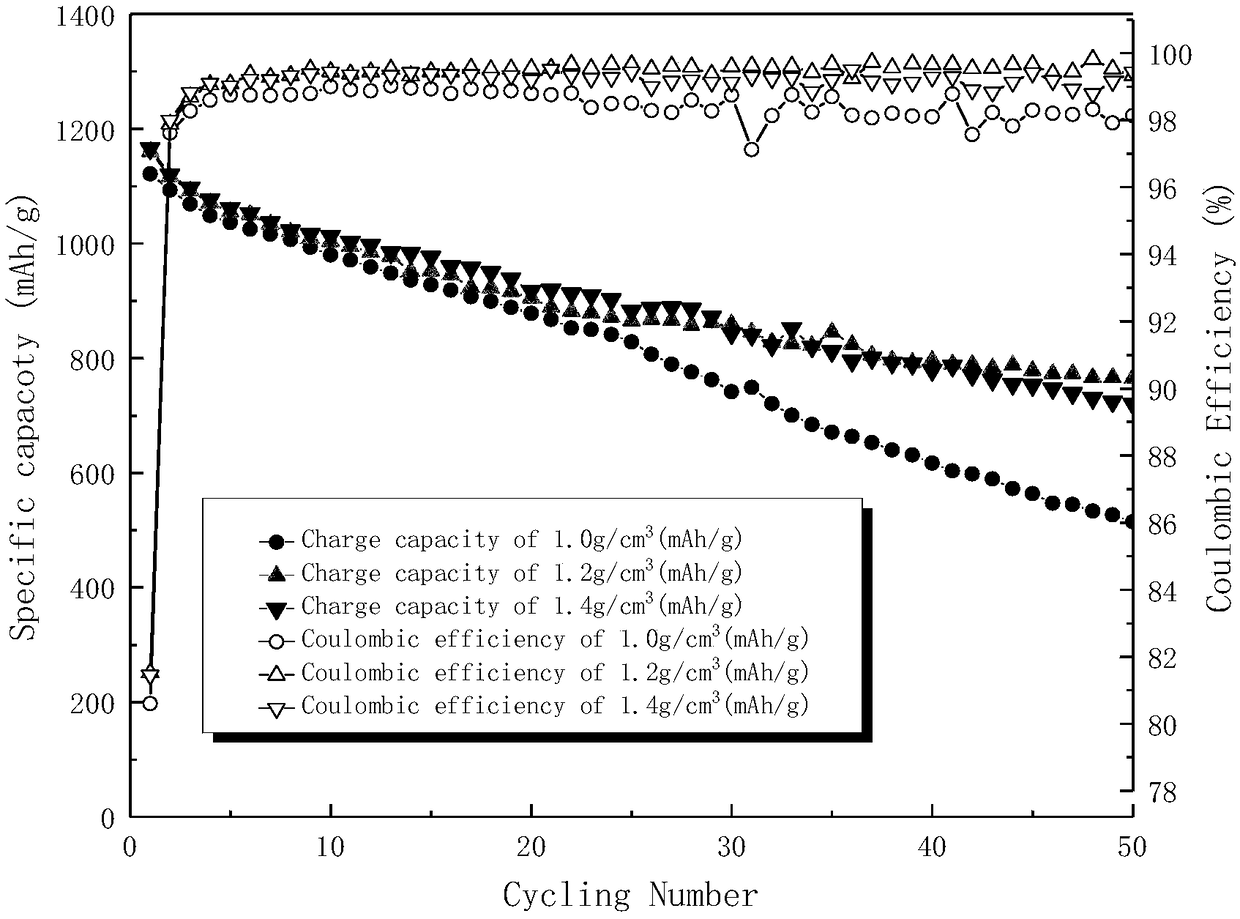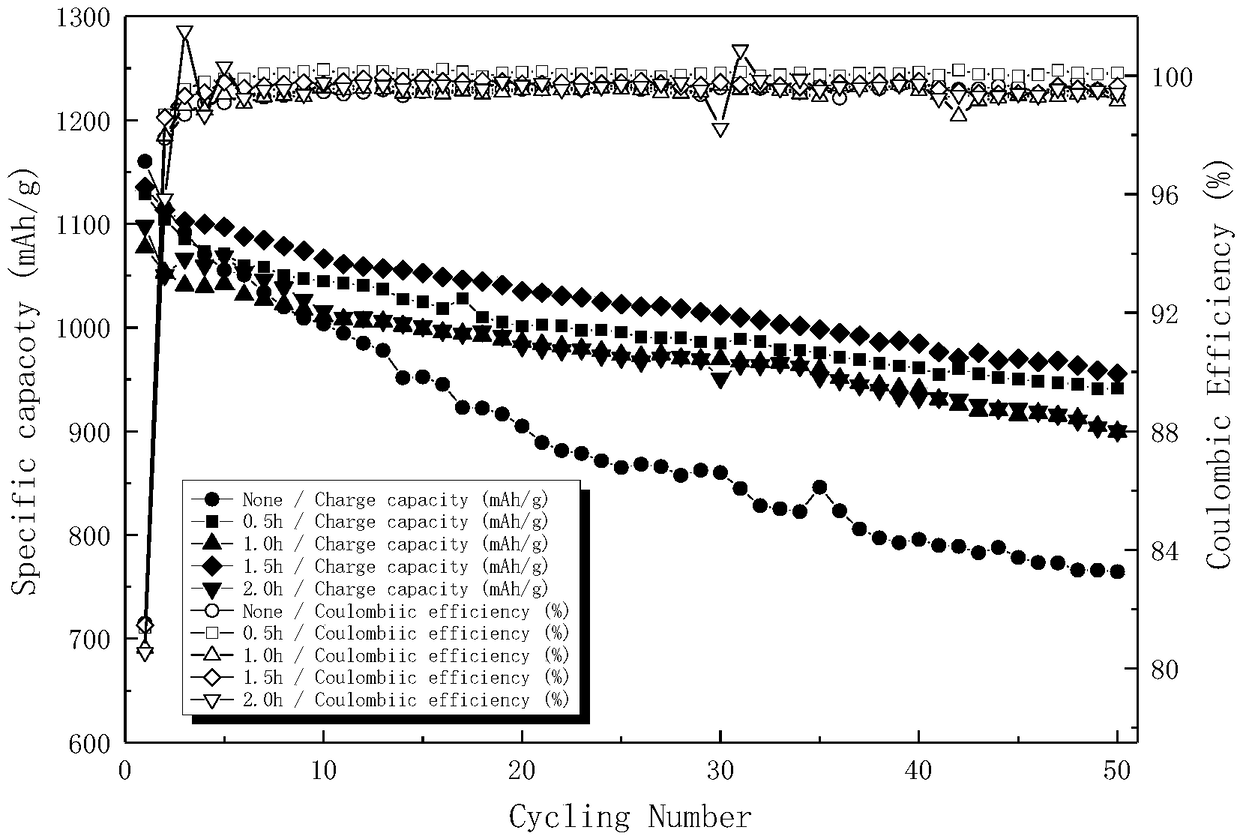Silicon-based electrode with adjustable pore structure and preparation method of silicon-based electrode
A pore structure, silicon-based technology, applied in electrode manufacturing, electrode rolling/calendering, battery electrodes, etc., can solve the problems of poor mechanical stability of electrodes, achieve low price, buffer volume change, and improve cycle stability.
- Summary
- Abstract
- Description
- Claims
- Application Information
AI Technical Summary
Problems solved by technology
Method used
Image
Examples
Embodiment 1
[0041] In this example, the active material used in the preparation of raw materials is 81% commercial high-capacity silicon-based composite negative electrode materials (including silicon carbon, silicon oxygen carbon, silicon and silicon alloys, etc.), with a particle size of 4-30 μm. The conductive additive is a mixed conductive agent of Super-P 5% and carbon nanofiber 2%. The binder is a mixed binder of 10% polyimide (commercially available, 45% solid content) and 2% polyvinylidene fluoride (5% solid content, NMP solvent). All of the above are mass ratios.
[0042]A method for preparing a high specific capacity silicon-based electrode with a variable pore structure is as follows:
[0043] 1) Add the binder to the N-methylpyrrolidone organic solvent, adjust the solid content of the mixture to 30%, and stir manually for 15 minutes; add a conductive agent, and stir manually for 15 minutes; add silicon-based active materials, and stir manually for 15 minutes, After manual st...
Embodiment 2
[0049] In this example, the active material used in the preparation of raw materials is 81% commercial high-capacity silicon-based composite negative electrode materials (including silicon carbon, silicon oxygen carbon, silicon and silicon alloys, etc.), with a particle size of 4-30 μm. The conductive additive is a mixed conductive agent of Super-P 5% and carbon nanotube 2%. The binder is a mixed binder of 10% polyimide and 2% polyvinylidene voltaic. The pore-forming additive is 10% of the total amount of the aforementioned raw materials.
[0050] A method for preparing a high specific capacity silicon-based electrode with a variable pore structure is as follows:
[0051] 1) Add the binder to the N-methylpyrrolidone organic solvent, adjust the solid content of the mixture to 30%, and stir manually for 15 minutes; add a conductive agent, and stir manually for 15 minutes; add silicon-based active materials, and stir manually for 15 minutes, Add ammonium carbonate, a pore-formi...
Embodiment 3
[0058] The raw material is the same as in Example 2, wherein the addition ratio of ammonium carbonate is 10%.
[0059] A method for preparing a high specific capacity silicon-based electrode with a variable pore structure is as follows:
[0060] 1) Add the binder to the N-methylpyrrolidone organic solvent, adjust the solid content of the slurry to 30%, and stir manually for 15 minutes; add the conductive agent, and stir manually for 15 minutes; add silicon-based active materials, stir manually for 15 minutes, and add The pore-forming agent ammonium carbonate with a content of 10% and a D50 of 10 μm was manually stirred for 15 minutes, and then placed in a Flucker high-shear dispersing emulsifier for 40 minutes at a speed of 1800 rpm to obtain a slurry;
[0061] 2) Coat the slurry on the surface of the current collector at a coating speed of 4-5m / min, and vacuumize during coating to obtain a semi-finished negative electrode piece; Treat for 120min; after drying, cut into discs...
PUM
| Property | Measurement | Unit |
|---|---|---|
| Areal density | aaaaa | aaaaa |
| Average pore size | aaaaa | aaaaa |
| Particle size | aaaaa | aaaaa |
Abstract
Description
Claims
Application Information
 Login to View More
Login to View More - R&D
- Intellectual Property
- Life Sciences
- Materials
- Tech Scout
- Unparalleled Data Quality
- Higher Quality Content
- 60% Fewer Hallucinations
Browse by: Latest US Patents, China's latest patents, Technical Efficacy Thesaurus, Application Domain, Technology Topic, Popular Technical Reports.
© 2025 PatSnap. All rights reserved.Legal|Privacy policy|Modern Slavery Act Transparency Statement|Sitemap|About US| Contact US: help@patsnap.com



